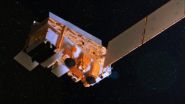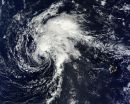(Press-News.org) New maps of Saturn's moon Titan reveal large patches of trace gases shining brightly near the north and south poles. These regions are curiously shifted off the poles, to the east or west, so that dawn is breaking over the southern region while dusk is falling over the northern one.
The pair of patches was spotted by a NASA-led international team of researchers investigating the chemical make-up of Titan's atmosphere.
"This is an unexpected and potentially groundbreaking discovery," said Martin Cordiner, an astrochemist working at NASA's Goddard Space Flight Center in Greenbelt, Maryland, and the lead author of the study. "These kinds of east-to-west variations have never been seen before in Titan's atmospheric gases. Explaining their origin presents us with a fascinating new problem."
The mapping comes from observations made by the Atacama Large Millimeter/submillimeter Array (ALMA), a network of high-precision antennas in Chile. At the wavelengths used by these antennas, the gas-rich areas in Titan's atmosphere glowed brightly. And because of ALMA's sensitivity, the researchers were able to obtain spatial maps of chemicals in Titan's atmosphere from a "snapshot" observation that lasted less than three minutes.
Titan's atmosphere has long been of interest because it acts as a chemical factory, using energy from the sun and Saturn's magnetic field to produce a wide range of organic, or carbon-based, molecules. Studying this complex chemistry may provide insights into the properties of Earth's very early atmosphere, which may have shared many chemical characteristics with present-day Titan.
In this study, the researchers focused on two organic molecules, hydrogen isocyanide (HNC) and cyanoacetylene (HC3N), that are formed in Titan's atmosphere. At lower altitudes, the HC3N appears concentrated above Titan's north and south poles. These findings are consistent with observations made by NASA's Cassini spacecraft, which has found a cloud cap and high concentrations of some gases over whichever pole is experiencing winter on Titan.
The surprise came when the researchers compared the gas concentrations at different levels in the atmosphere. At the highest altitudes, the gas pockets appeared to be shifted away from the poles. These off-pole locations are unexpected because the fast-moving winds in Titan's middle atmosphere move in an east–west direction, forming zones similar to Jupiter's bands, though much less pronounced. Within each zone, the atmospheric gases should, for the most part, be thoroughly mixed.
The researchers do not have an obvious explanation for these findings yet.
"It seems incredible that chemical mechanisms could be operating on rapid enough timescales to cause enhanced 'pockets' in the observed molecules," said Conor Nixon, a planetary scientist at Goddard and a coauthor of the paper, published online today in the Astrophysical Journal Letters. "We would expect the molecules to be quickly mixed around the globe by Titan's winds."
At the moment, the scientists are considering a number of potential explanations, including thermal effects, previously unknown patterns of atmospheric circulation, or the influence of Saturn's powerful magnetic field, which extends far enough to engulf Titan.
Further observations are expected to improve the understanding of the atmosphere and ongoing processes on Titan and other objects throughout the solar system.
INFORMATION:
NASA's Astrobiology Program supported this work through a grant to the Goddard Center for Astrobiology, a part of the NASA Astrobiology Institute. Additional funding came from NASA's Planetary Atmospheres and Planetary Astronomy programs. ALMA, an international astronomy facility, is funded in Europe by the European Southern Observatory, in North America by the U.S. National Science Foundation in cooperation with the National Research Council of Canada and the National Science Council of Taiwan, and in East Asia by the National Institutes of Natural Sciences of Japan in cooperation with the Academia Sinica in Taiwan.
An interdisciplinary team of researchers from the University of Texas Medical Branch, and Winship Cancer Institute of Emory University have identified small molecules that can represent a new class of anticancer drugs with a novel target for the treatment of lung cancer. These findings are detailed in Nature Communications. A PCT patent (WO 2013028543 A1) was jointly documented by these two Institutes for the invention.
Survival outcomes remain poor for lung cancer patients in large part because of lung cancer's resistance to conventional therapies. Programmed cell death, ...
While space debris was the uncontrolled adversary in the award-winning space thriller film "Gravity," space debris, also known as "space junk," is an ongoing real-life concern for teams managing satellites orbiting Earth, including NOAA-NASA's Suomi National Polar-orbiting Partnership, or Suomi NPP, satellite. It is not unusual for satellites that have the capability of maneuvering to be repositioned to avoid debris or to maintain the proper orbit.
On an otherwise quiet Sunday on September 28, the Suomi NPP mission team was monitoring a possible close approach of a debris ...
Many cancer patients use dietary supplements such as vitamins, minerals and herbs or other botanicals but often don't tell their doctor.
This gap in communication can happen when patients believe that their doctors are indifferent or negative toward their use of these supplements. As a result, patients may find information about dietary supplements from unreliable sources, exposing themselves to unneeded risks. Since information on these dietary supplements is limited, researchers from the University of Texas Medical Branch describe a practical patient-centered approach ...
AMES, Iowa – News of a school shooting or a homicide involving a teenage suspect always leads to the question of why? It is human nature to want an explanation or someone to blame, and policymakers try to pinpoint a cause in an effort to prevent it from happening again. But too often, the speculation or rush to judgment clouds reality, said Matt DeLisi, a professor of sociology and criminal justice at Iowa State University.
"Anytime you have violence, such as a school shooting, people gravitate to single-item explanations that cite mental illness, guns, bullying ...
CHICAGO --- A nano-sized discovery by Northwestern Medicine® scientists helps explain how bipolar disorder affects the brain and could one day lead to new drug therapies to treat the mental illness.
Scientists used a new super-resolution imaging method -- the same method recognized with the 2014 Nobel Prize in chemistry -- to peer deep into brain tissue from mice with bipolar-like behaviors. In the synapses (where communication between brain cells occurs), they discovered tiny "nanodomain" structures with concentrated levels of ANK3 -- the gene most strongly associated ...
VIDEO:
This rainfall analysis showed that Gonzalo generated several areas over the Atlantic Ocean where rainfall totals topped 12 inches (red). Fay's maximum rainfall appeared between 4 and 8 inches (green)....
Click here for more information.
The Tropical Rainfall Measuring Mission or TRMM satellite can estimate rainfall rates from its orbit in space and that data is used to create a rainfall analysis and calculate total rainfall for weather events in the tropics. NASA used ...
Tropical Storm Ana was being battered by wind shear when NASA's Terra satellite passed overhead and saw the bulk of showers and thunderstorms pushed north and east of the center.
NASA's Terra satellite flew over Tropical Storm Ana as it was moving past Hawaii on Oct. 21 at 21:30 UTC (5:30 p.m. EDT) and the Moderate Resolution Imaging Spectroradiometer (MODIS) instrument took a visible picture of the storm. The MODIS image showed that the strong southwesterly wind shear that was affecting the storm on Oct. 20 continued through Oct. 21 as the bulk of clouds and showers ...
WORCESTER, MA –Using an innovative exome sequencing strategy, a team of international scientists led by John Landers, PhD, at the University of Massachusetts Medical School has shown that TUBA4A, the gene encoding the Tubulin Alpha 4A protein, is associated with familial amyotrophic lateral sclerosis (ALS), a fatal neurological disorder also known as Lou Gehrig's Disease. Details of the study were published today in Neuron.
Exome sequencing, in contrast to whole genome sequencing, relies on sequencing only the protein-coding genes in a genome and has been an effective ...
The Bureau of Reclamation has released a report summarizing six years of testing coatings to control the attachment of quagga and zebra mussels to water and power facilities. Since the study began in 2008, Reclamation has tested more than 100 coatings and materials.
"Controlling attachment of invasive quagga and zebra mussels on Bureau of Reclamation facilities is important to ensure water delivery and hydropower generation," principal researcher Allen Skaja said. "Though we have tested many different coatings, three durable foul-release coatings are showing promise ...
Worcester, Mass. – People paralyzed by spinal cord injuries lose mechanical strength in their leg bones faster, and more significantly, than previously believed, putting them at greater risk for fractures from minor stresses, according to a new study by a research team at Worcester Polytechnic Institute (WPI).
The results suggest that physicians need to begin therapies for spinal cord injury patients sooner to maintain bone mass and strength. The data also serve as warning to physicians treating patients with osteoporosis to think beyond the standard bone density ...





